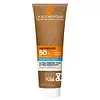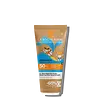La Roche-Posay Anthelios Eco Tube SPF 50 Versus La Roche-Posay Anthelios Dermo-Pediatrics Wet Skin Lotion SPF 50+
What's inside
What's inside
 Key Ingredients
Key Ingredients

 Benefits
Benefits

 Concerns
Concerns

 Ingredients Side-by-side
Ingredients Side-by-side

Water
Skin ConditioningIsopropyl Palmitate
EmollientAlcohol Denat.
AntimicrobialDicaprylyl Ether
EmollientBis-Ethylhexyloxyphenol Methoxyphenyl Triazine
Skin ConditioningDiisopropyl Adipate
EmollientDiisopropyl Sebacate
EmollientEthylhexyl Triazone
UV AbsorberButyl Methoxydibenzoylmethane
UV AbsorberGlycerin
HumectantPropanediol
SolventDiethylamino Hydroxybenzoyl Hexyl Benzoate
UV FilterTriethanolamine
BufferingTocopherol
AntioxidantC12-22 Alkyl Acrylate/Hydroxyethylacrylate Copolymer
StabilisingOxidized Starch Acetate
Skin ConditioningPhenylbenzimidazole Sulfonic Acid
UV AbsorberOryza Sativa Cera
Skin ConditioningAcrylates Copolymer
Acrylates/C10-30 Alkyl Acrylate Crosspolymer
Emulsion StabilisingAluminum Hydroxide
EmollientCaprylyl Glycol
EmollientDrometrizole Trisiloxane
UV AbsorberHydroxyacetophenone
AntioxidantHydroxyethylcellulose
Emulsion StabilisingPEG-20
HumectantStearic Acid
CleansingTerephthalylidene Dicamphor Sulfonic Acid
UV AbsorberTitanium Dioxide
Cosmetic ColorantTrisodium Ethylenediamine Disuccinate
Xanthan Gum
EmulsifyingWater, Isopropyl Palmitate, Alcohol Denat., Dicaprylyl Ether, Bis-Ethylhexyloxyphenol Methoxyphenyl Triazine, Diisopropyl Adipate, Diisopropyl Sebacate, Ethylhexyl Triazone, Butyl Methoxydibenzoylmethane, Glycerin, Propanediol, Diethylamino Hydroxybenzoyl Hexyl Benzoate, Triethanolamine, Tocopherol, C12-22 Alkyl Acrylate/Hydroxyethylacrylate Copolymer, Oxidized Starch Acetate, Phenylbenzimidazole Sulfonic Acid, Oryza Sativa Cera, Acrylates Copolymer, Acrylates/C10-30 Alkyl Acrylate Crosspolymer, Aluminum Hydroxide, Caprylyl Glycol, Drometrizole Trisiloxane, Hydroxyacetophenone, Hydroxyethylcellulose, PEG-20, Stearic Acid, Terephthalylidene Dicamphor Sulfonic Acid, Titanium Dioxide, Trisodium Ethylenediamine Disuccinate, Xanthan Gum
Water
Skin ConditioningHomosalate
Skin ConditioningDrometrizole Trisiloxane
UV AbsorberEthylhexyl Salicylate
UV AbsorberBis-Ethylhexyloxyphenol Methoxyphenyl Triazine
Skin ConditioningEthylhexyl Triazone
UV AbsorberGlycine
BufferingButyl Methoxydibenzoylmethane
UV AbsorberIsohexadecane
EmollientAlcohol Denat.
AntimicrobialPropanediol
SolventDicaprylyl Ether
EmollientStyrene/Acrylates Copolymer
Dimethicone
EmollientAcrylates/Dimethicone Copolymer
Skin ConditioningP-Anisic Acid
MaskingAscorbyl Palmitate
AntioxidantCarbomer
Emulsion StabilisingDisodium EDTA
Glyceryl Oleate
EmollientHydrogenated Palm Glycerides Citrate
EmollientLecithin
EmollientNylon-12
PEG-8 Laurate
EmulsifyingPhenoxyethanol
PreservativeTocopherol
AntioxidantTriethanolamine
BufferingWater, Homosalate, Drometrizole Trisiloxane, Ethylhexyl Salicylate, Bis-Ethylhexyloxyphenol Methoxyphenyl Triazine, Ethylhexyl Triazone, Glycine, Butyl Methoxydibenzoylmethane, Isohexadecane, Alcohol Denat., Propanediol, Dicaprylyl Ether, Styrene/Acrylates Copolymer, Dimethicone, Acrylates/Dimethicone Copolymer, P-Anisic Acid, Ascorbyl Palmitate, Carbomer, Disodium EDTA, Glyceryl Oleate, Hydrogenated Palm Glycerides Citrate, Lecithin, Nylon-12, PEG-8 Laurate, Phenoxyethanol, Tocopherol, Triethanolamine
Ingredients Explained
These ingredients are found in both products.
Ingredients higher up in an ingredient list are typically present in a larger amount.
Alcohol Denat. is an alcohol with a denaturant property. It is created by mixing ethanol with other additives.
This ingredient gets a bad rep because it is irritating and drying - mostly due to its astringent property. Astringents draw out natural oils in tissue, constricting pores and leaving your skin dried out.
However, alcohol denat. is not all that bad.
Due to its low molecular weight, alcohol denat. tends to evaporate quickly. One study on pig skin found half of applied alcohol evaporated in 10 seconds and less than 3% stayed on skin.
This also helps other ingredients become better absorbed upon application.
Studies are conflicted about whether this ingredient causes skin dehydration. One study from 2005 found adding emollients to propanol-based sanitizer decreased skin dryness and irritation. Another study found irritation only occurs if your skin is already damaged.
Small amounts of alcohol are generally tolerated by oily skin or people who live in humid environments.
The rule of thumb is if this alcohol is near the end of an ingredients list, it will probably not affect your skin much.
Also...
This ingredient has antimicrobial and solvent properties.
The antimicrobial property helps preserve products and increase their shelf life. As a solvent, it helps dissolve other ingredients.
Other types of astringent alcohols include:
Learn more about Alcohol Denat.You might know this ingredient as Tinosorb S or Bemotrizinol. It is a UV filter that covers both UVA and UVB rays.
This ingredient has two peak UV absorption peaks ( 310 and 340 nm) and is able to absorb both UV-A and UV-B rays. This ingredient works by preventing UV rays from reaching and damaging your skin.
On top of that - it is highly photostable and helps prevent the photodegration of other sunscreen ingredients such as avobenzone.
Tinosorb S is allowed in the EU, Australia, and Asia. It is close to being approved by the FDA and we'll hopefully get this ingredient in the U.S. by late 2025.
Fun fact: Tinosorb S is the most effective UV absorber at maximum concentration (measured by SPF) permitted in the EU.
This ingredient is oil-soluble, so your oil-cleansers will take this right off at night.
Learn more about Bis-Ethylhexyloxyphenol Methoxyphenyl TriazineAlso known as Avobenzone, this ingredient is a chemical sunscreen filter that provides protection in the UV-A range.
Avobenzone is globally approved and is the most commonly used UV-A filter in the world.
Studies have found that avobenzone becomes ineffective when exposed to UV light (it is not photostable; meaning that it breaks down in sunlight). Because of this, formulations that include avobenzone will usually contain stabilizers such as octocrylene.
However, some modern formulations (looking at you, EU!) are able to stabilize avobenzone by coating the molecules.
Avobenzone does not protect against the UV-B range, so it's important to check that the sunscreen you're using contains other UV filters that do!
The highest concentration of avobenzone permitted is 3% in the US, and 5% in the EU.
Learn more about Butyl MethoxydibenzoylmethaneDicaprylyl Ether is created from caprylic acid. It is a texture-enhancer and emollient.
As an emollient, Dicaprylyl Ether is non-comedogenic. It helps soften and smooth the skin by creating a barrier on top. This barrier helps trap moisture in, helping to hydrate the skin.
Dicaprylyl Ether gives a non-greasy feel and better spreadability to products.
Learn more about Dicaprylyl EtherDrometrizole Trisiloxane is a UV filter that provides both UV-A (344 nm) and UV-B (303 nm) protection.
This ingredient is photostable and studies show it to be generally safe and effective. The compound Meroxyl XL is owned by L'Oreal while Drometrizole trisiloxane can be found in other sunscreen brands.
It is currently approved for use in the EU, Canada, Australia, and Japan. However, it is not yet approved for use in the US.
This ingredient is often used with other sunscreen ingredients, such as Ecamsule.
Learn more about Drometrizole TrisiloxaneEthylhexyl Triazone is a modern chemical sunscreen that protects from UV-B radiation.
It is the most effective of existing UV-B filters, as it provides the highest level of photo-stable absorption. It protects from the entire UV-B range (280 to 320nm), with it's highest level of protection at 314nm.
Ethylhexyl Triazone is oil soluble, oderless and colorless, which mean it is able to be incorporated into a variety of different formulations.
It is not currently available within the United States due to slow changing FDA regulations. Outside of the US, it is used in formulations at concentrations up to 5%.
Learn more about Ethylhexyl TriazonePropanediol is an all-star ingredient. It softens, hydrates, and smooths the skin.
It’s often used to:
Propanediol is not likely to cause sensitivity and considered safe to use. It is derived from corn or petroleum with a clear color and no scent.
Learn more about PropanediolTocopherol (also known as Vitamin E) is a common antioxidant used to help protect the skin from free-radicals and strengthen the skin barrier. It's also fat soluble - this means our skin is great at absorbing it.
Vitamin E also helps keep your natural skin lipids healthy. Your lipid skin barrier naturally consists of lipids, ceramides, and fatty acids. Vitamin E offers extra protection for your skin’s lipid barrier, keeping your skin healthy and nourished.
Another benefit is a bit of UV protection. Vitamin E helps reduce the damage caused by UVB rays. (It should not replace your sunscreen). Combining it with Vitamin C can decrease sunburned cells and hyperpigmentation after UV exposure.
You might have noticed Vitamin E + C often paired together. This is because it is great at stabilizing Vitamin C. Using the two together helps increase the effectiveness of both ingredients.
There are often claims that Vitamin E can reduce/prevent scarring, but these claims haven't been confirmed by scientific research.
Learn more about TocopherolTriethanolamine is an emulsifier and pH adjuster. It is created using ethylene oxide and ammonia. This gives Triethanolamine a nitrogen core and a similar scent to ammonia.
As an emulsifier, it prevents ingredients from separating and enhances texture by adding volume to a product.
PH adjusters are common in cosmetic products. The pH of a product can affect the effectiveness of other ingredients. A product with a high pH may also irritate the skin.
Learn more about TriethanolamineWater. It's the most common cosmetic ingredient of all. You'll usually see it at the top of ingredient lists, meaning that it makes up the largest part of the product.
So why is it so popular? Water most often acts as a solvent - this means that it helps dissolve other ingredients into the formulation.
You'll also recognize water as that liquid we all need to stay alive. If you see this, drink a glass of water. Stay hydrated!
Learn more about Water